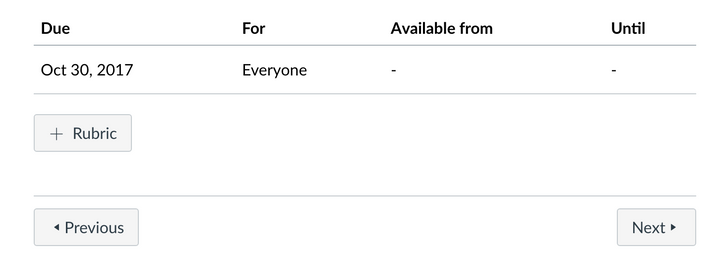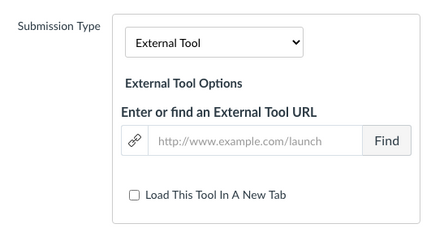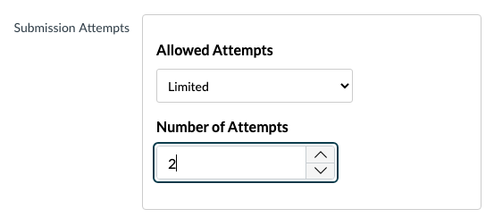Everything you can do with Assignments
- Subscribe to RSS Feed
- Mark as New
- Mark as Read
- Bookmark
- Subscribe
- Printer Friendly Page
- Report Inappropriate Content
It has been amazing to experience the effort faculty have been putting into their classes in this time of social distancing in 2020. I've seen many instructors go above and beyond simply transferring their face-to-face course activities to the online space; they are stretching their teaching and implementing teaching practices that are new to them and really improve the quality of the student experience. I'm so proud of all this effort and work! A shout out to all of you trying new things to make this time more than a time for coping and instead are growing!
Canvas Assignments have lots of options available that make them really useful as you try all these new teaching practices. For each option below, I am describing some possible uses and providing you links with instructions for setting them up and running them.*
- Rubrics
- Assignments not worth points
- Assignments that use external tools
- Limiting the number of attempts
- Group Assignments
- Peer Review
- Using different due dates for students or sections
Rubrics
We will start before you even edit an assignment. At the bottom of the Assignment page, before you click edit, you can see where you can add a rubric.
Rubrics are great because they can speed up your grading by allowing you to quickly evaluate work with several criteria, without having to repeatedly write comments to students explaining where the work was lacking or excelled. Those descriptions are all contained in the rubric! Rubrics also increase consistency in grading. Use them for more than writing, and always make rubrics available to students before assignments are due. Good students will use rubrics to make sure they meet all of your expectations for their work.
Assignments not worth points
Broadening your definition of assignments can really help your students stay on track in course. Many instructors use assignments only for things that are turned in and graded. But students know they have many other things to do, and putting those into Canvas as assignments with due dates can help keep students on track. Readings are a great example. If you want students to complete readings or watch videos before class, you can enter them as Assignments with due dates, and set them so you never have to grade them. Drafts can also be submitted as assignments without points but it gives you a place to score and provide feedback to students on their works in progress. You have two options for setting up assignments to not be worth points, and there are subtle differences.
An Assignment set to Display grade as "Not Graded" does not show up in students' nor instructors' Grades. It will still be in the Assignments list. To keep your assignments list organized, you may want to create an Assignment Group called "Ungraded assignments". The Points and Submission type boxes are hidden with this setting, along with many other assignment options, but you can set all dates. This allows the assignment to show to students in the calendar and To Do list, so it is good for pre-lecture readings.
Assignments with the "Do not count this assignment towards the final grade" box checked show a blue warning message to students and instructors stating, "This assignment does not count toward the final grade." You can set a point value and score assignments, but scores are not included in grade calculations, so this can be a good way to have students submit drafts. The assignment will show to both instructors and students in Assignments and Grades, though the Grade listing for students has an exclamation point that can be clicked to explain it is not included in the grade.
A note about setting an assignment to zero points: Zero point assignments are counted in grades. When you enter scores, they will be included in the grade as extra credit.
Assignments that use External Tools
One of the benefits of Canvas is the number of learning tool integrations that are available. Some of these integrations are accessed from within the assignment under Submission type: External Tool. If you click find you will see a list of tools available at your institution.
There is no way I can cover the variety of tools available through the external tools option, and what you have available will depend on which integrations your administrative team has set up in your instance of Canvas. Many External Tools require students or your institution to purchase licensing or services.. For many tools, they cannot be combined with the Group Assignment setting. Also any Rubrics need to be set up for the assignment before selecting the External Tool option. Once set, the Rubric may no longer show to students but it will be available in SpeedGrader for grading. Each External Tool has its own . . . quirks, so read what you can before implementing it and be prepared to troubleshoot.
Here are a few popular External Tools at our institution:
- Turnitin
- Google Docs Cloud Assignment
- Voicethread
- Flipgrid
- Many publishers provide integrations here, all unique to their accounts.
Limiting the number of attempts
The option to limit attempts is relatively new.
Typically, students can submit work to an assignment with online submissions multiple times, from the time it opens on the Available Date, up to the Due Date, and past the due date if the Until Date is set later. If there is no Until date, students can submit until the course is closed. Setting a limit to the number of attempts means when those attempts are up, students can no longer submit regardless of any days. Submissions are still closed at the Until date, even if there are submission attempts left to use.
Group Assignments
Group assignments allow one student to turn in collaborative group work, and when it is scored everyone in the group gets that score (exceptions can be made). They are definitely a more complex assignment and require you to use more Canvas functionality. Group assignments have lots of benefits. They allow students to learn from their peers and experience immediate feedback on their work from their peers, which can improve retention. For instructors it can greatly reduce the amount of time spent grading and you may get better quality work. Instructors and students do have to deal with the problems that can come from having to work with other people, but that is a valuable skill to develop. If you are attempting this your first time, find someone experienced with using groups and they can provide you with lots of valuable advice for setting things up to go well and dealing with issues when things go wrong.
- Creating Groups in a Group Set: Manually or Automatically
- How do I assign an assignment to a course group?
- Best Practices for Grading Group Assignments
- The Nitty Gritty: Modifying Group Membership Midterm
Peer Review
Tired of having students bring 3 copies of their papers to class so their peers can rush through reading them to provide superficial comments? Canvas Peer Review is for you! This tool can be especially useful for drafts of papers or large assignments. Students can learn from their peers both by what feedback they are given and by seeing what other students are doing. Using this for smaller formative assignments can help reduce your grading load while giving students more immediate feedback (assuming you are a slow grader like I am). Because scores come from other students, students may express frustration if these are large point, summative assignments.
Students submit their work for review. Who reviews the assignment can be randomly set or manually set. Though it can make this assignment more complex, I highly recommend you use a rubric with this assignment. It can help students more thoroughly and appropriately judge the quality of work. The final grade for the submission must be given in Speedgrader by the instructor or TA, though all the student comments and completed rubrics can be seen so the instructor can decide on a score.
A couple of things are tricky. There is only one due date, the date the initial submission is due. I recommend that you add the following to the title for your assignment, "[Submission due: XXX, Reviews due: XXX}." Set your due date to the time the submission is due and your until date to when the reviews are due. If you want to give students a score for completing the reviews they were assigned, you'll need to do that manually in a separate assignment. In the description of the Peer Review I often include these instructions:
"We are using this peer review assignment to let your peers give you feedback on your assignment. You will visit this assignment 3 times: First to submit your assignment, second to find and complete your peer reviews, and the third and final time to find and read the reviews you were given."
Here are the resources to help you successfully use this tool:
This is another complex assignment because it happens in several steps. You'll need to provide good instructions for student to help them successfully navigate.
- How do I create a peer review assignment?
- How do I assign Peer Reviews - automatically or manually
- How do I submit a peer review to an assignment?( for students) - This actually shows how to find the reviews students need to complete and how to find the reviews done of their submissions.
- Feedback Overview (Video 3:07 for Students)
- Peer Reviews Canvas Tutorial Video Series (Video 3:11 for students)
- How do I view student peer review comments as an instructor?
Use different Due Dates for students or sections
A very common question is how to let some students turn things in late or allow different sections of a class turn in assignments at different times. These are done using the +Add button at the bottom of the Assign box.
Once you click add, an additional Assign box appears under the original. Underneath "Assign to" is a box where you can begin typing in student names or section names. You will need to type in the names, as the dropdown box does not show all the options. Once you choose which student or section will get the different dates, you will see the first assign box switch from "Everyone" to "Everyone Else." Now you can set new dates for that student or section.
A very common mistake is to use only one Assign box and delete everyone and replace it with a student or section. This will remove this assignment from everyone else in the class. Often this is a mistake and if done after grading, all the grades disappear. The fix is easy, just assign it back to everyone and the scores return. Then add a new Assign box to set the new adjusted dates.
You also should know that when importing assignments with multiple due dates into a new course site, the only one Assign box is made and sometimes it is left blank, and thus not assigned to everyone. You'll need to manually check due dates for assignments modified in this way.
Important note on Due Dates and Groups: You cannot assign an assignment to a specific group, unless this is a group assignment itself.
Conclusion
That is a great deal of information all gathered in one place. I hope it is useful to you. Please comment with other tips and tricks you have discovered using the assignment tool in Canvas.
*This Tech Tip is written by academic technologists working at the University of Minnesota. Your installation of Canvas may have different settings and tools.
You must be a registered user to add a comment. If you've already registered, sign in. Otherwise, register and sign in.







